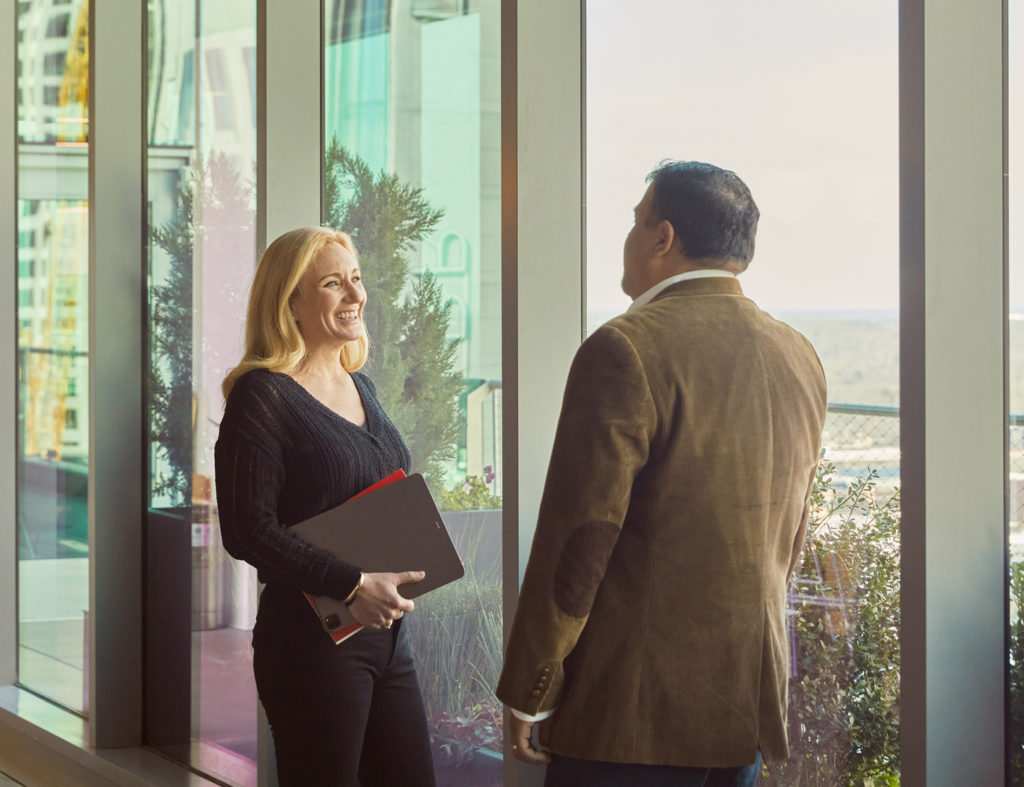In a world experiencing climate change, breathing life into old structures is one of the most regenerative things we can do for our planet. It has been suggested by the World Green Building Council that 11% of global carbon emissions are a direct result of construction. What if we could reduce that to 10% or 9% by simply taking advantage of our existing building stock?
A FORMER RETAIL SPACE BECOMES A THRIVING WORKPLACE
There is something unique and elegantly beautiful about adapting an old space to a new typology. The recent shopping mall to workplace conversion by Truliant Federal Credit Union is a prime example of how successful this can be for our environment and bank accounts.
Little worked with the leaders of Truliant to prepare an economic comparison of purchasing and converting an old Macy’s department store versus constructing a new building on the existing campus. Truliant determined that purchasing and adapting the Macy’s store into their Operations Center would save them over 10 million dollars.
Always focused on its members, Truliant purchased the Macy’s store and successfully completed the conversion to support its growth needs. Truliant went even further, adding solar panels and beehives to the roof, improving our world one step at a time.

WEAVING TOGETHER THE PAST, PRESENT AND FUTURE
Another exciting example can be found in downtown Rock Hill, SC. The partnership between The Keith Corporation and Capital Broadcasting Company has committed to saving an old warehouse and re-energizing this section of town. A true mixed-use dream, The Thread conversion includes retail, office, and multi-family. The team carved several courtyards out of the heart of the building, creating a powerful sense of place. To capture the carbon impact, Little used the Cove Tool app to compare new construction to this adaptive reuse. The result showed a reduction of more than 20,000 metric tons of embodied and operational emissions over 50 years.

But something else hides within the walls of adaptive reuse—learning. What can we learn from the world today as office buildings struggle to convert to residential? Who knows what the future of transportation holds in store for us. It makes you ponder the impact of parking deck demolition alone in our collective future.
The scale at which office space is becoming vacant has staggered the industry. Some even say that converting office buildings to residential is the key to the housing crisis and a real opportunity to improve our cities and the planet. Flexibility makes the environments we live in engaging and is at the heart of mixed-use communities. There is a reason that we strive to find a live/work/play environment. It is dynamically intertwined—more residential drives more retail. In turn, they both fuel more office, which then impacts residential. It is a fragile dance that is constantly adjusting and adapting.
TURNING TODAY’S CHALLENGES INTO LESSONS FOR A BETTER FUTURE
The office space is not dead, to be clear. It is evolving and will remain in our systemic typology of life. Those converting office buildings to residential spaces are learning hard lessons these days. The office building plates are too deep, the glass typologies don’t align, and the mechanical systems are ineffective, to note a few. For decades, the golden rectangle for efficient office floor plates—120’x240′ clothed in floor-to-ceiling glass veil—has dominated the industry to a fault. Even more egregious have been ridiculous parking ratios. Our drive for parking convenience has resulted in trillions of unnecessary and unused parking stalls.
What can the pain of today’s conversions teach us about how we should design? How do we wake up long enough to understand the interconnected living nature of our cities and design with a sense of flexibility at the forefront, right alongside scale and proportionality? Imagine if we learn and our children’s children experience a world where construction carbon emissions are reduced to 5%. Imagine a world where adapting structures is commonplace.
Learn more about the working world and how it is redefining its culture. Little’s recently published Beyond Workplace III book explores the possibilities, the realities, and even the impossible.

